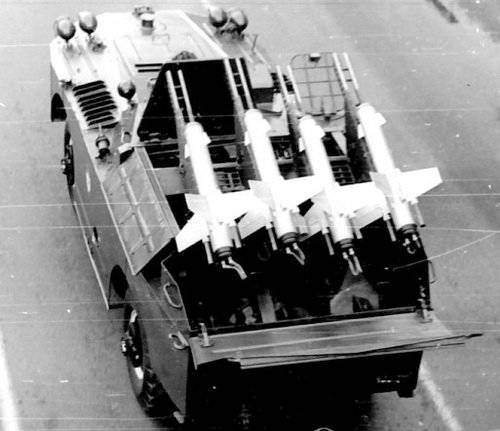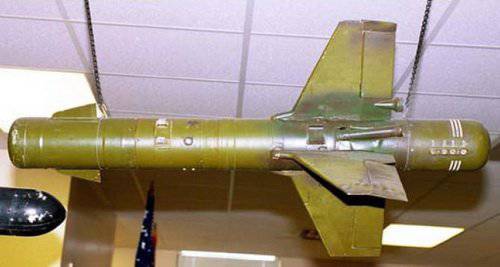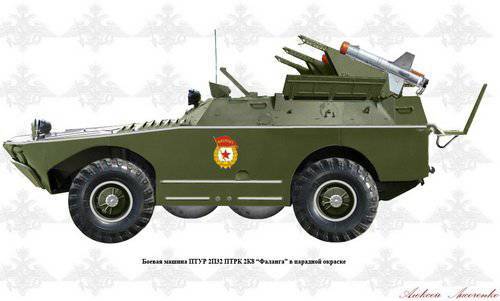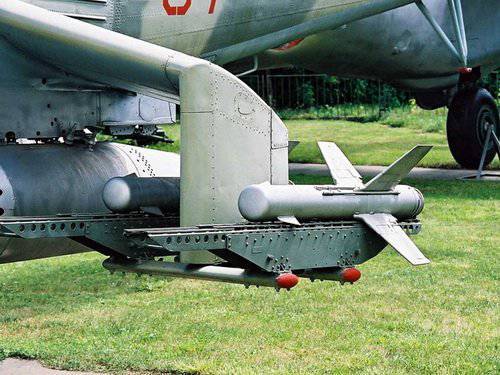Phalanga ATGM
The Phalanga ATGM ensured the destruction of armored targets at a distance of 2 500 meters, the minimum firing range was 500 meters. The rocket provided armor penetration at the level of 560 mm (at an angle of 90 degrees). The launch weight of the missile complex was 28,5 kg, and the weight of the 2P32 combat vehicle created on the basis of the BRDM-1 was 6 050 kg. The complex could be deployed from a marching position to a combat one in 30 seconds, but with the preparation of the equipment for launching the missiles, this would take from 2 to 3 minutes.
The overall layout of the anti-tank missile 3М11 was made taking into account the length limitations imposed by the placement on the base of the BRDM-1, and had a blunted fairing. The use of a radio control rocket required from the creators of placing in its tail part quite cumbersome equipment in accordance with the realities of those days. Because of this, the rocket propulsion system was made according to the scheme with 2-me oblique nozzles and consisted of starting and cruising engines. The controls were located at the rear edge of the wings of the elevon.

An air pressure accumulator was placed on the rocket to power the pneumatic steering mechanisms - a special compressed air cylinder. Compressed air also entered the turbogenerator, providing power to the rocket equipment. Thanks to this decision, the rocket did not have to put temperature-sensitive batteries or batteries. The Phalanx missiles on the launcher were placed in an X-shaped pattern, and after launch, the rocket, turning around in a roll at 45 degrees, made its flight with a cruciform arrangement of wings. At the same time, for the best compensation of gravity in the horizontal plane, the designers provided a special small destabilizer, thanks to which in the pitch channel the aerodynamic scheme of the rocket became intermediate between tailless and duck. On the horizontal pair of rocket consoles were mounted tracer.
Due to the fact that the wing consoles were made collapsible, the dimensions of the rocket in the transport position were quite small and were only 270 on 270 mm. Consoles were opened and prepared for combat use manually, after that the wingspan of the rocket reached 680 mm. The rocket body diameter was 140 mm, Dyne - 1147 mm. Starting weight 28,5 kg.
Already after 4, after the completion of the work, the first modernization of the complex saw the light. The new 9М17 rocket of the Phalanga-M complex received a small-sized powder gyro with a spinup, which occurred due to the combustion of a powder charge. With the use of a gyroscope, it was possible to reduce the time of preparing the rocket for launch. Instead of the propulsion system of the 2-x engines (starting and cruising), a lighter, single-chamber, dual-mode engine was used, the fuel supply of which was doubled. As a result of the modernization, the range of the missile was increased to 4000 meters, the average speed increased from 150 to 230 m / s, and the launch weight of the rocket increased to 31 kg.
After 4 years passed, the Phalanga-P (“Flute”) complex entered the army, possessing semi-automatic missile guidance at the target. When launching, the operator only had to hold the target in the crosshairs, while the guidance teams were automatically developed and issued by helicopter or ground equipment, which tracked the position of the rocket along its tracer. The minimum shooting range has been reduced to 450 meters. Under the semi-automatic modification of the complex, a new ground-based launcher was developed — the 9P137 combat vehicle, created on the basis of the BRDM-2.

It is also worth noting that the appearance of guided missile weapons in helicopters in our country is connected with the Phalanga complex. The first tests in this field began in the 1961 year, when 1 4М3 missiles were installed on MI-11. But at that time, the military could not yet assess the potential and the prospect of such an deployment of anti-tank systems. In the future, tests were carried out already with 9М17 missiles, but, despite their positive outcome, the helicopter complex was never accepted for service.
The fate of the complex under the abbreviation K-4В, which was to be installed on Mi-4AB helicopters, became more successful. Each helicopter carried 4 anti-tank missiles "Phalanx-M", put into service in the 1967 year. The 185 helicopters of the previously built Mi-4А helicopters were specially equipped for this complex. Well, in 1973, this complex was successfully tested on the basis of the Mi-8TV, and later on the basis of the first truly combat helicopter Mi-24. Each of them also carried on 4 missiles complex "Phalanx-M".
BRDM-1
The creation of an armored reconnaissance vehicle (BRDM-1) began at the end of 1954 in the design bureau of the Gorky Automobile Plant, led by the leading designer of the company V.K. Scar. It was originally planned to create a BRDM as a floating version of the well-known in the troops BTR-40 (it was no coincidence that the car even received the BTR-40П index). However, in the course of the work, the designers came to the conclusion that it would not be possible to restrict myself to just modifying an existing machine. During the design work began to emerge a new machine, which had no analogues not only in the USSR, but also in the world.
The demands of the military to overcome the trenches and trenches led to the creation of a unique chassis, which consisted of the main four-wheel propulsion and 4 additional wheels, which were located in the central part of the vehicle and were designed to overcome the trenches. The 4 central wheels, if necessary, were lowered and driven by a specially designed transmission. Thanks to this, the BRDM was easily transformed from a four-wheeled vehicle into an eight-wheeled vehicle, which was able to overcome trenches and obstacles as wide as 1,22 meters. The main wheels of the BRDM-1 had a centralized swap system, which was already tested on the BTR-40 and BTR-152 models.
For the possibility of forcing water obstacles, the car was supposed to be equipped with a traditional propeller, but later on during the discussions, the designers decided on a water cannon, which was already designed for easy floating tank PT-76. Such a water cannon was more "tenacious" and compact. In addition, it could be used to pump water from the body of the armored vehicle and increased its maneuverability on water - the turning radius on the water surface was only 1,5 meters.

The BRDM-1 had a sealed carrying case, welded from rolled armor plates of various thickness - 6,8 and 12 mm. An armored cabin equipped with two inspection hatches with plug-in bullet-proof glass blocks was welded to the hull. In the stern of the car there was a double hatch. The combat weight of the vehicle was 5 600 kg, the maximum speed 80 km / h. The machine could carry an 5 man (crew member 2 + paratrooper 3).
It is on the basis of the BRDM-1 was created combat vehicle 2P32. Its main weapons were anti-tank missiles 3М11 "Phalanx". This self-propelled complex ATGM had 4 guides and could carry out up to 2 rocket launches per minute. The machine’s ammunition consisted of 8 anti-tank missiles, as well as an RPG-7 anti-tank grenade launcher.
Aviation option "Phalanx-PV"
The Phalanga-PV airborne anti-tank missile system is used to destroy enemy armored vehicles with a manual control method provided that they have direct optical visibility of the target, or in semi-automatic mode. The complex was created in the KB precision engineering (chief designer AE Nudelman) on the basis of the complex "Phalanga-M". The Phalanga-PV ATGM was adopted by the army in the 1969 year, and from the 1973 year, the Mi-24D attack helicopters, which carried the 4М9П ATGM, were launched into the series. In the future, this rocket became the main weapon for many other types of helicopters, on which the Phalang-M complex had previously been deployed. The launchers of the Mi-17AB and Mi-4TV helicopters could fit up to 8 of such missiles simultaneously.
The complex was manufactured at the Kovrovsky Mechanical Plant and sold for export. It is assumed that he is still in service with the armies of Afghanistan, Cuba, Egypt, Libya, Syria, Yemen, Vietnam, Bulgaria, Hungary and the Czech Republic. In the west, this complex was named AT-2C "Swatter-C" (Russian fly swatter).

The 9М17П rocket is made according to the normal aerodynamic configuration and is almost completely similar to the Phalanx-M rocket. The main difference between the missiles is the use of a new radio command semi-automatic control system, which was interfaced with the Raduga-F equipment and installed on the helicopter rocket carrier. A missile was aimed at a target using the 3-x point method. In the role of controls were aerodynamic control surfaces.
Currently, the developer of the rocket offers on the market its deep modernization, which has the best armor penetration. The new level of penetration guarantees the defeat of the modern MBT of the enemy, including those with dynamic protection. In the course of modernization, the range of missile applications was significantly expanded by using various types of warheads (detonating, fragmentation and other warheads).
New versions of the rocket were presented at the MAKS air show in Zhukovsky in August 1999. The modified version of the rocket could be used on all launchers in service: on Mi-24 helicopters and 9P137 self-propelled launchers in manual and semi-automatic guidance modes, when launched from PU 9P124 installations - only in manual control mode.
The upgraded versions of 9М17П retained all the operational and combat characteristics of previous modifications, differing only in the types of warheads used:
The 9М17П rocket, the 1 modification is completed with a warhead with increased efficiency to overcome armor protection up to 400 mm thick (at an angle of 60 degrees from the normal). The new missile warhead is equivalent to a cumulative warhead weighing 4,1 kg.
Rocket 9М17П 2 modification is completed with an improved warhead 7,5 kg total weight, with the possibility of guaranteed overcoming of armor more than 400 mm thick (at an angle of 60 degrees from the normal)
Information